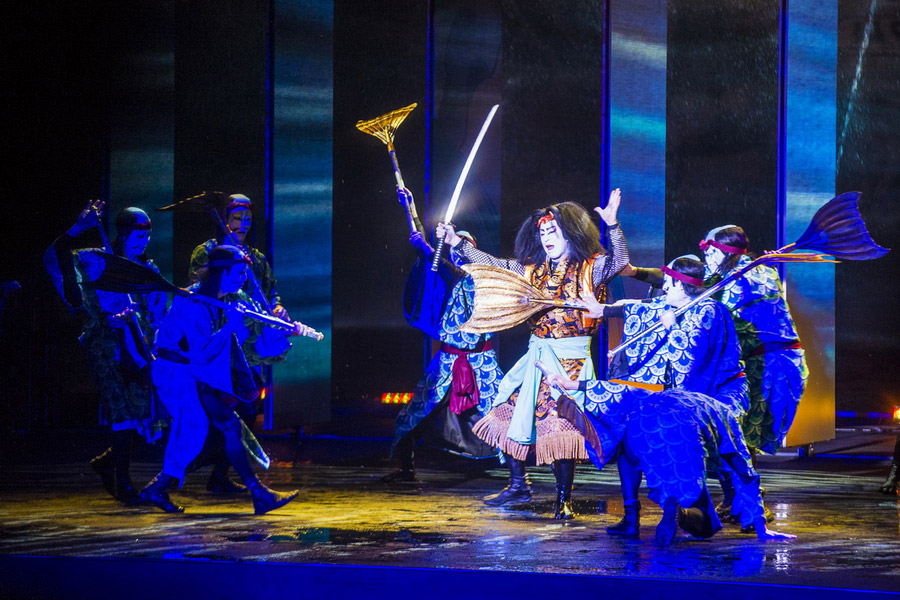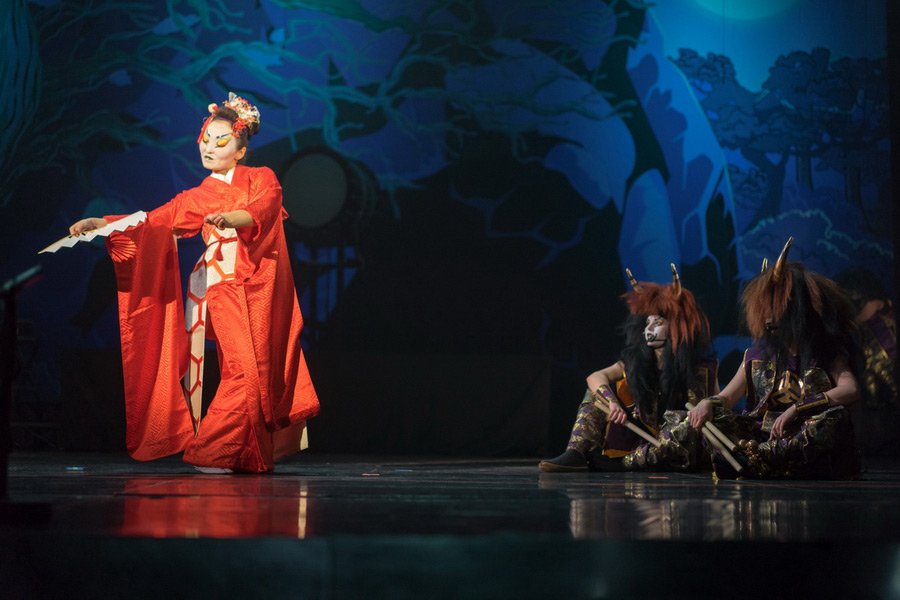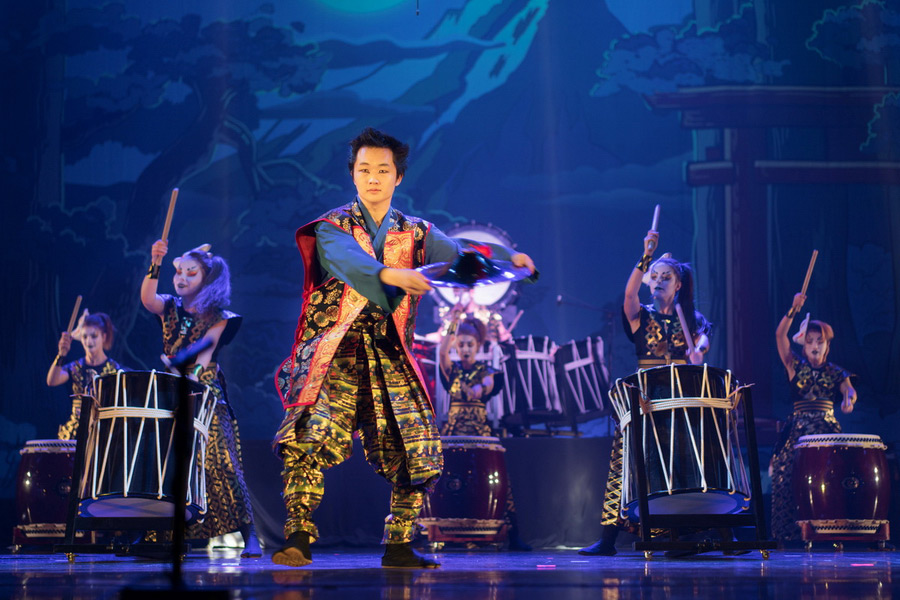Traditional Japanese Theater

All forms of traditional Japanese theater are dazzling. Every gesture, sound, grimace, and prop has a hidden message. Although the plot and dialogues might seem intricate to the unprepared theatergoer, the number of admirers of this spectacular performance is steadily increasing.
In 2008, Kabuki, Noh, Kyogen, and Bunraku were officially recognized and inscribed on the prestigious UNESCO List of Intangible Cultural Heritage. This recognition underscores the profound significance of these art forms in shaping Japanese culture and history and their enduring status as cherished national performing arts.
Noh Theater

Noh, influenced by earlier forms of entertainment and Chinese literature, began taking shape in Japan during the 14th century. Originally depicting true events, the plots became more formalized over time.
Noh was played outdoors originally, so its stage was always roofed. That is why the modern stage features a roof to keep the idea of performing in the open fields. Backstage, there is a simple panel called kagami-ita, featuring a painting of a green pine tree, which symbolizes longevity. Adjacent to the left side of the stage is the hashigakari, a bridge-like pathway where actors enter and exit.
The theater features three groups of characters: the lead character, or shite, who wears a mask; the supporting actor, or waki; and the comical actor, or kyogen. Noh, as well as Kabuki performers, are men; they also play women's roles. The typical plays have a religious background: the spirit of the recently deceased master can't rest in peace and asks a wandering monk to help him reach nirvana. The appearance and performance of actors playing spirits and demons are outstanding.
The Noh theater has five types of masks: gods, people, beautiful women, insane women, and demons. The covered facial expressions of the actor still convey deep emotions via body language and movements. The mask changes during the play.
Learn about the following symbols to enjoy the performance:
- A high-pitched voice usually belongs to a young man, woman, or nobleman, while a deep voice: to an old, desperate character or a person of a lower social position.
- The fan stands for different items, depending on its orientation. When held open downwards, it can represent a sword, archery, jar, or water. When held open from the right side, it symbolizes happiness and excitement.
- The color of the robe also matters. White symbolizes honor and high status, and red represents youthfulness and happiness. An actor clad in a blue robe means a powerful character.
- Noh theater utilizes drums and flutes. Tambourines sometimes serve as a musical accompaniment to dances or actors playing deities, spirits, or demons.
- Kyogen are small plays used between the Noh acts. These are comical dialogues performed without masks. Noh and Kyogen are called nohgaku together.
Kabuki Theater

Kabuki theater, founded by the increasingly popular shrine maiden Izumo no Okuni, emerged in Kyoto in 1604. While early Kabuki featured female actors, some of whom were associated with prostitution, this was just one facet of the theater's complex cultural landscape during its formative years. Consequently, the government banned women's performances in 1629.
Contemporary Kabuki theater draws inspiration from Western models, except for hanamichi and mawari-butai. Hanamichi is a flower walkway for a dramatic entrance and exit from the main stage. The mawari-butai, dating back to the 17th century, is a revolving stage for transition scenes as the story advances.
Virtuoso playing is paramount in Kabuki theater because actors portray distinct roles, such as boisterous Aragoto, the gentle hero-lover Vagoto, and the Oyama, a woman played by a male actor. Kabuki actors generally focus on specific roles. They spend many hours studying the movements, facial expressions, and speech patterns of geishas to authentically portray women from ancient Japan.
Some theaters might provide English translation headsets. Kabuki performances typically consist of two or three acts. While some long-running plays may allow for viewing single acts, most spectators usually attend the entire performance. Each part can last up to three or four hours, with an intermission included. Even without English narration available via earphones, you can still appreciate the amazing acting, dancing, singing, sets, and props.
Where to See Noh and Kabuki?
You can experience Noh and Kabuki in several theaters in Japan.
- The National Noh Theater in Tokyo. Don’t forget to visit a small museum of masks and colorful costumes.
- Kyoto Kanze Kaikan also offers private Noh performances and a chance to learn some movements with the artist.
- Tokyo’s National Theater is a great place to enjoy Kabuki.
- Apart from opera, ballet, dance, and drama, the New National Theater stages Kabuki plays.
Bunraku Theater

In the captivating tradition of Bunraku theater, a fascinating form of puppetry, the puppeteers take center stage. A trio of specialized actors expertly controls each puppet. The most inexperienced puppeteer, known as the ashizukai, begins by manipulating the legs of the puppet. As their skills develop, they progress to the role of the hidarizukai, responsible for controlling the left hand. The most experienced puppeteer, known as the omozukai, manipulates the head and facial expressions, along with the right arm and upper body of the puppet. The intricate training required for each operator can span several decades, resulting in a masterful artistry that brings the puppets to life on stage.
In Japanese bunraku theater, puppeteers, who operate the dolls and hide behind them, wear black tights and hoods to symbolize their intended invisibility during the performance. When the puppeteers are clad in black, and the audience has their eyes on the dolls, they stop noticing the actors. Only renowned artists may occasionally reveal their faces during curtain calls or special performances, as a mark of honor or recognition for their expertise and contribution to the art form.
Like Noh and Kabuki theaters, bunraku has its own set of beloved characters, including a samurai, a young man, a woman with a complex moral background, and a beauty who can instantly transform into a demon.
Where to Experience Bunraku?
Today, bunraku is held in modern theaters. You can buy tickets either for the afternoon or the evening performance.
- We recommend heading to the National Bunraku Theater in Osaka since Osaka is the hometown of Bunraku.
- The National Theater in Tokyo is also a great place to watch the show. However, the theater is currently under reconstruction (as of May 2024).

